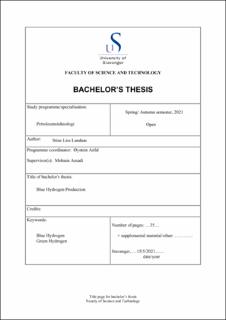| dc.description.abstract | Hydrogen as a chemical energy carrier for green energy will play an important role in the reduction of CO2 emissions. Today 76% of the world’s hydrogen production comes from fossil fuels, from natural gas and coal without carbon capture and storage processes. The emissions form fossil-fuel based hydrogen counts for 830 MtCO2/year according to the International Energy Agency (IEA) which corresponds to the yearly emissions from both Indonesia and the UK. These emissions can be cut removed by converting over to sorption enhanced steam methane reforming methods with carbon capture and storage. The most cost completive method of producing hydrogen is blue hydrogen, which averages between 1.5-2.5 USD per kilo hydrogen produced with CCUS. The production cost for green hydrogen is between 2.5-6.8 USD per kilo hydrogen.
The price differences between blue and green hydrogen is due to cost of renewable energy and the difference in energy efficiency. The production of hydrogen from Polymer electrolyte membrane electrolysis or PEM water electrolysis has a current energy efficiency of 55-62%, which is predicted to rise to 62-74% by 2030. The energy efficiency of alkaline electrolysis between 55-69%, while the energy efficiency of a large scale SMR will have an energy efficiency of 70-85% lower heating value of hydrogen. | |
